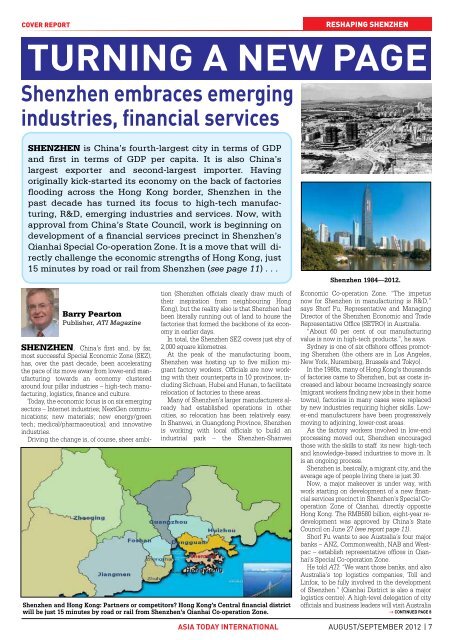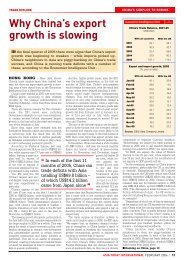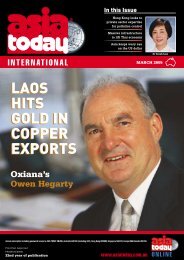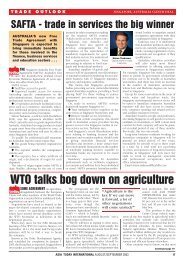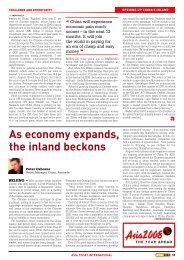download - Asia Today International
download - Asia Today International
download - Asia Today International
You also want an ePaper? Increase the reach of your titles
YUMPU automatically turns print PDFs into web optimized ePapers that Google loves.
COVER REPORT<br />
RESHAPING HEADING SHENZHEN FOR HERE<br />
TURNING A NEW PAGE<br />
Shenzhen embraces emerging<br />
industries, financial services<br />
SHENZHEN is China’s fourth-largest city in terms of GDP<br />
and first in terms of GDP per capita. It is also China’s<br />
largest exporter and second-largest importer. Having<br />
originally kick-started its economy on the back of factories<br />
flooding across the Hong Kong border, Shenzhen in the<br />
past decade has turned its focus to high-tech manufacturing,<br />
R&D, emerging industries and services. Now, with<br />
approval from China’s State Council, work is beginning on<br />
development of a financial services precinct in Shenzhen’s<br />
Qianhai Special Co-operation Zone. It is a move that will directly<br />
challenge the economic strengths of Hong Kong, just<br />
15 minutes by road or rail from Shenzhen (see page 11) . . .<br />
Barry Pearton<br />
Publisher, ATI Magazine<br />
SHENZHEN, China’s first and, by far,<br />
most successful Special Economic Zone (SEZ),<br />
has, over the past decade, been accelerating<br />
the pace of its move away from lower-end manufacturing<br />
towards an economy clustered<br />
around four pillar industries – high-tech manufacturing,<br />
logistics, finance and culture.<br />
<strong>Today</strong>, the economic focus is on six emerging<br />
sectors – Internet industries; NextGen communications;<br />
new materials; new energy/green<br />
tech; medical/pharmaceutical; and innovative<br />
industries.<br />
Driving the change is, of course, sheer ambition<br />
(Shenzhen officials clearly draw much of<br />
their inspiration from neighbouring Hong<br />
Kong), but the reality also is that Shenzhen had<br />
been literally running out of land to house the<br />
factories that formed the backbone of its economy<br />
in earlier days.<br />
In total, the Shenzhen SEZ covers just shy of<br />
2,000 square kilometres.<br />
At the peak of the manufacturing boom,<br />
Shenzhen was hosting up to five million migrant<br />
factory workers. Officials are now working<br />
with their counterparts in 10 provinces, including<br />
Sichuan, Hubei and Hunan, to facilitate<br />
relocation of factories to these areas.<br />
Many of Shenzhen’s larger manufacturers already<br />
had established operations in other<br />
cities, so relocation has been relatively easy.<br />
In Shanwei, in Guangdong Province, Shenzhen<br />
is working with local officials to build an<br />
industrial park – the Shenzhen-Shanwei<br />
Shenzhen and Hong Kong: Partners or competitors Hong Kong’s Central financial district<br />
will be just 15 minutes by road or rail from Shenzhen’s Qianhai Co-operation Zone.<br />
Shenzhen 1984—2012.<br />
Economic Co-operation Zone. “The impetus<br />
now for Shenzhen in manufacturing is R&D,”<br />
says Shorf Fu, Representative and Managing<br />
Director of the Shenzhen Economic and Trade<br />
Representative Office (SETRO) in Australia.<br />
“About 60 per cent of our manufacturing<br />
value is now in high-tech products.”, he says.<br />
Sydney is one of six offshore offices promoting<br />
Shenzhen (the others are in Los Angeles,<br />
New York, Nuremberg, Brussels and Tokyo).<br />
In the 1980s, many of Hong Kong’s thousands<br />
of factories came to Shenzhen, but as costs increased<br />
and labour became increasingly scarce<br />
(migrant workers finding new jobs in their home<br />
towns), factories in many cases were replaced<br />
by new industries requiring higher skills. Lower-end<br />
manufacturers have been progressively<br />
moving to adjoining, lower-cost areas.<br />
As the factory workers involved in low-end<br />
processing moved out, Shenzhen encouraged<br />
those with the skills to staff its new high-tech<br />
and knowledge-based industries to move in. It<br />
is an ongoing process.<br />
Shenzhen is, basically, a migrant city, and the<br />
average age of people living there is just 30.<br />
Now, a major makeover is under way, with<br />
work starting on development of a new financial<br />
services precinct in Shenzhen’s Special Cooperation<br />
Zone of Qianhai, directly opposite<br />
Hong Kong. The RMB580 billion, eight-year redevelopment<br />
was approved by China’s State<br />
Council on June 27 (see report page 11).<br />
Shorf Fu wants to see Australia’s four major<br />
banks – ANZ, Commonwealth, NAB and Westpac<br />
– establish representative offices in Qianhai’s<br />
Special Co-operation Zone.<br />
He told ATI: “We want those banks, and also<br />
Australia’s top logistics companies, Toll and<br />
Linfox, to be fully involved in the development<br />
of Shenzhen.” (Qianhai District is also a major<br />
logistics centre). A high-level delegation of city<br />
officials and business leaders will visit Australia<br />
g CONTINUED PAGE 8<br />
ASIA TODAY INTERNATIONAL AUGUST/SEPTEMBER 2012 | 7


